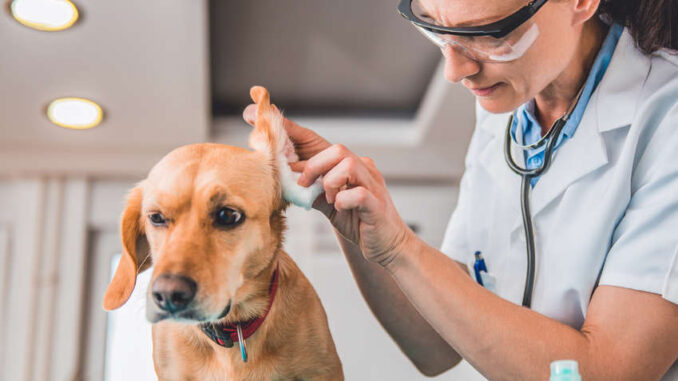
Ear mites are more commonly thought of as a cat problem, but they can show up in our dog’s ears from time to time. A problem with ear mites, besides causing an intensely itchy ear issue, is that an ear mite infestation is indistinguishable from other ear complications without the help of a veterinarian. With that in mind, let’s look at some pictures of ear mites in dogs and then talk about what can be done for them.
What are Ear Mites? What Do They Look Like?
Ear mites are tiny parasites that go by the scientific name Otodectes cynotis. They live most commonly in the ear canal of dogs and cats, but can exist anywhere on the skin. These tiny creatures are only 1-2 millimeters long and somewhat resemble a tick. While some people with keen vision can see these little white specks moving around on a dog’s ear, a microscope is often necessary to diagnose.
Ear mites feed on the ear wax and oils from your dog’s ears and skin, and they aren’t afraid to jump ship from one pet to the next. These highly contagious parasites can run ramped in the outdoor pet population, according to a study nearly 25% of cats can be affected. Dogs are less commonly a problem, but as much as 7% of our canine companions can be infested.
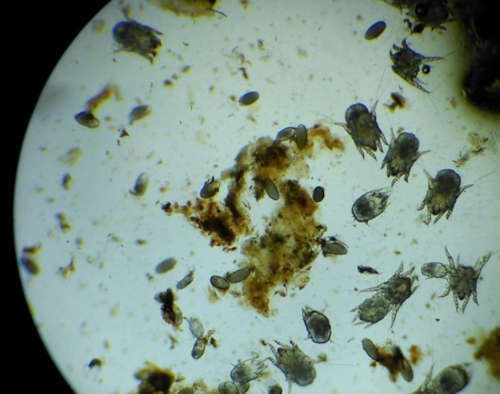
Signs of Ear Mites in Dogs [with pictures]
Ear mite infestations look a lot like bacterial or yeast infections in our dog’s ears. So, there is definitely some overlap in the signs that you will see. However, there are a few subtle differences that you may notice that we’ll also talk about.
Itching/Scratching
Ear mite infestations are incredibly itchy! They will have your dog digging at their ears with all four feet and they will then try to rub their head across your carpet or furniture. If available, your dog may even enlist your help to scratch their ears. This is often enough to cause bleeding and wounds around your pup’s ears that just further exacerbate the problem. The scratching may be relentless, keeping you and your dog up at night, and may even be so intense that your dog won’t eat.

Black, Crusty Debris in Ears
Ear mites create a black, flaky debris when they set up shop in your pup’s ears. You may notice this debris when you flip back your dog’s ears or in severe cases, you may see it falling out of your dog’s ears as they scratch. This debris is often described as looking like coffee grounds due to the flakey nature which may look a little different than the greasy, brown discharge seen with some ear infections.
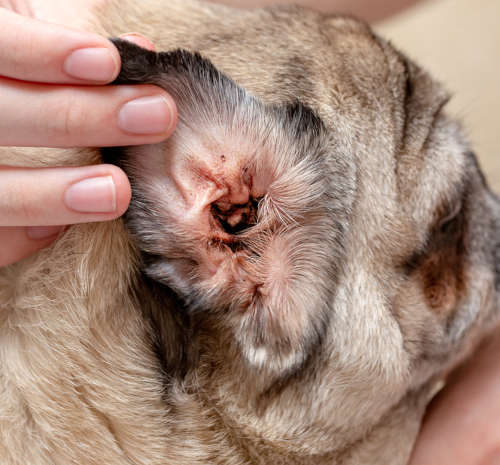
Scabs
Ear mites themselves don’t cause a lot of trauma to your pup, unless it’s a very severe infestation. What causes trauma is how your pup reacts to the itchiness and inflammation. Some dogs with scratch with such intensity that they create scabs and bleeding wounds around their ears. You may see small, red scabs inside the ear, or larger wounds on the outside of the ear.
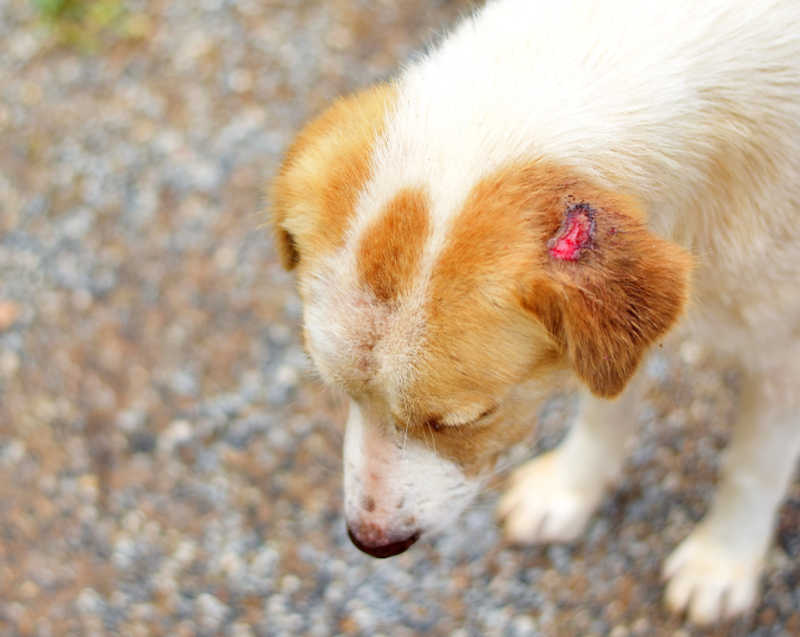
Skin Inflammation
Ear infections due to bacteria and yeasts or infestations with ear mites can all cause skin inflammation in and around the ears. Part of this inflammation is due to the infection, and part of it is due to a dog scratching. The skin around and in the ears may appear red, swollen and you may even feel the heat coming off of it. Click here to view an example image of a skin inflammation issue in a dog’s ear.
Head Tilt
A head tilt may be seen with an ear mite infestation, as well as an ear infection. Dogs will tilt their head towards the side that’s affected, sort of as a way to try to get rid of the irritation in their ear. If both ears are affected, you may instead see a dog hold their head low to the ground. Head tilts will look the same whether it’s ear mites, an infection or even some neurological issues.

Pictures of Ear Mites in Dogs

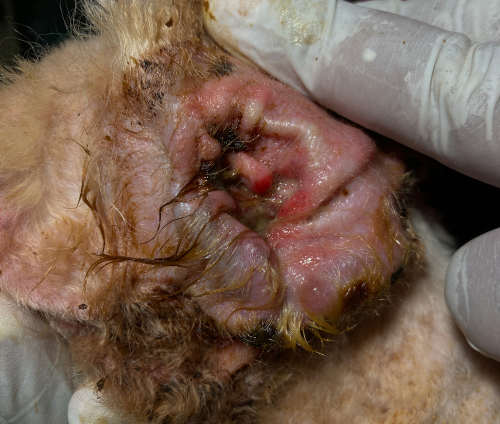
Other Ear Issues in Dogs that Look Like Ear Mites
An itchy, red ear doesn’t always mean ear mites. In fact, it will more commonly be due to something else. Just what is that something else?
Bacterial Ear Infection
Itching is a common sign that bacterial ear infections and ear mites share. They will also have a similar looking discharge or debris in the ear. Both can cause redness and swelling in the ear canal and a head tilt.
However, ear mites tend to be itchier. Take the itchiness that comes with a bacterial ear infection and double it. With ear mites, dogs will scratch seemingly 24 hours a day. They may also kick their leg when you give them a little rub behind the ears. Bacterial ear infections also tend to smell.
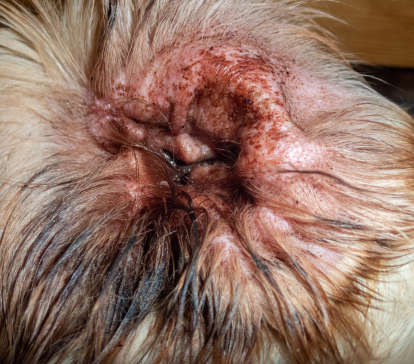
Yeast Ear Infections
Yeast infections and ear mites also have many things in common. Itching, of course, but also a possible head tilt, loss of balance, and red, swollen ears.
The difference between the two may be that, again, ear mites are itchier. Your dog may hardly take a break from working at those ears. Yeast infections tend to produce a foul odor and can have a yellowish or grayish, greasy discharge.
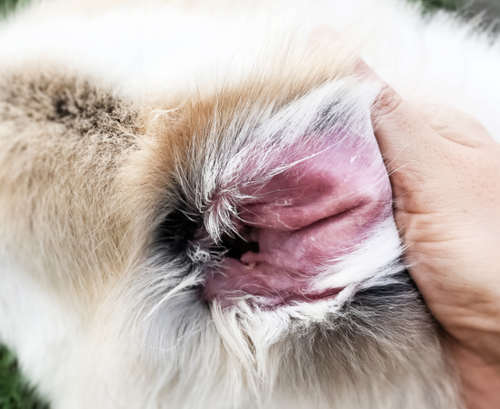
Learn more: Dog Ear Yeast Infection or Ear Mites? Our Veterinarians Explain, or view our yeast ear infection pictures.
How to Tell if your Dog Has Ear Mites or Other Ear Issues
Ear mites and ear infections have a lot in common. They all cause inflammation and itchiness in the ears along with a brownish discharge. This makes them very hard to tell each issue apart from the next without the help of a veterinarian.
The only way to definitively tell if your dog has ear mites versus an infection is to look at an ear swab under the microscope. Since many people do not have a microscope at their house, this is where your vet will come in to help. They can easily see ear mites under the microscope and be able to tell you the cause of your dog’s ear issues. Along with that, the vet will be able to assess the health of the ear besides the infestation to make sure medications and cleansers can be used safely.
The Importance of a Correct Diagnosis to Help Your Dog
There are at least three ear conditions that look very similar but that each require a very different treatment. Knowing what exactly is causing your dog’s itchy ears is important to know which treatment is best. Putting an antibiotic into an ear mite infestation won’t help and putting an anti-parasiticide on a yeast infection will do little to cure.
If these conditions aren’t treated, your dog risks injuring themselves with their vigorous scratching, which in turn, can lead to secondary infections of the skin around the ears. There is also a chance that they could do damage to the ear canal and hearing capabilities of the ear itself.
How Ear Mites in Dogs are Treated
After getting a proper diagnose by a veterinarian with an ear swab, it’s time to start getting your dog some relief. Hold off on doing anything at home, even with a diagnosis, because you’ll want to make sure a vet has checked that the ear drum is intact before applying any ear cleaner or medications. You may read about at-home treatments that include pouring mineral oil into the ear. This requires frequent treatments and can increase the risk of causing an ear infection, so it’s best to only use this treatment under a vet’s supervision.
Veterinary Treatments
There are many prescription medications to help deal with ear mites in dogs. Some are medications that are applied directly to the ear, others can be applied to the skin at the back of the neck, and some are given by injection. Depending on the medication and the severity of your dog’s infestation, repeat treatments may be needed.
Cleaning the ears with a good otic cleaner before applying any medications may provide some relief as well and give the medications a better chance at working.
Disclaimer: This website's content is not a substitute for veterinary care. Always consult with your veterinarian for healthcare decisions. Read More.


Be the first to comment